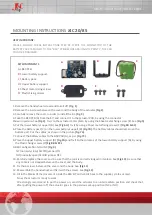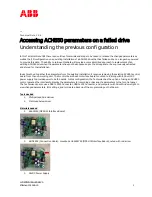
Pizzato Elettrica Srl
via Torino, 1
36063 MAROSTICA (VI)
ITALY
e-mail: [email protected]
web site: www.pizzato.com
Phone: +39.0424.470.930
ZE FOG55A22-EU
4/18
1 INFORMATION ON THIS DOCUMENT
1.1 Function
These operating instructions provide information on installation, connection and safe
use for the following articles:
CS FS-5
•••••
1.2 Target audience
The operations described in these operating instructions must be carried out by qua-
lified personnel only, who are fully capable of understanding them, and with the tech-
nical qualifications required for operating the machines and plants in which the safety
devices are to be installed.
1.3 Application field
These instructions apply exclusively to the products listed in paragraph Function, and
their accessories.
1.4 Original instructions
The Italian language version is the original set of instructions for the device. Versions
provided in other languages are translations of the original instructions.
2 SYMBOLS USED
This symbol indicates any relevant additional information
Attention: Any failure to observe this warning note can cause damage or malfun-
ction, including possible loss of the safety function.
3 DESCRIPTION
3.1 Device description
The safety device described in this manual is defined according to the Machinery
Directive 2006/42/EC as logic component for safety functions.
The safety modules to which these usage instructions refer are devices specifically
designed and manufactured for use on industrial machines. The safety function pro-
vides for the timing and check of a safe contact (17-18) based on the status of some
input signals to the module as well as the functional check of the module at each
re-start, according to the methods described in this document. There are also some
unsafe signalling contacts and some LEDs for displaying the state of the device.
3.2 Device functions
This device is suitable for the following applications: as a safety timer module in
safety circuits up to category 3 and PL d acc. to EN ISO 13849-1 and SIL CL 2 acc.
to EN 62061.
- Choice between automatic start or manual start.
with reference to the "automatic" operating mode, consider RES 1.2.3 of the
Machinery Directive 2006/42/EC: "For machinery functioning in automatic mode, the
starting of the machinery, restarting after a stoppage, or a change in operating condi-
tions may be possible without intervention, provided this does not lead to a hazardous
situation".
- LED indicators to signal the state of the device (Out, Fault) and the presence of a
power supply (Power).
- Screw terminals or plug-in terminals with screw connections or spring terminals (de-
pending on the model).
- Snap-mounting on DIN rails.
3.3 Intended use of the device
- The device described in these operating instructions is designed to be applied on
industrial machines.
- The direct sale of this device to the public is prohibited. Installation and use must be
carried out by qualified personnel only.
- The use of the device for purposes other than those specified in these operating
instructions is prohibited.
- Any use other than as expressly specified in these operating instructions shall be
considered unintended by the manufacturer.
- Also considered unintended use:
a) using the device after having made structural, technical, or electrical modifications
to it;
b) using the product in a field of application other than as described in paragraph
TEChNICAL DATA.
4 OPERATION
4.1 Function diagrams
CS FS-5•••••
Automatic
start
t
A
t
S
t
S
t
R
t
A
t<
condizione di
attivazione
uscite di
sicurezza
A1/A2 - B1/B2
CS FS-5•••••
Manual
start
t
A
t
S
t
S
t
R
t
A
t<
t
MIN
t
MIN
uscite di
sicurezza
start
condizione di
attivazione
A1/A2 - B1/B2
Legend:
t
A
:
adjustable release time:
0.3 … 3 s, 0.3 s steps
(articles CS FS-51••••)
1 … 10 s, 1 s steps
(articles CS FS-52••••)
3 … 30 s, 3 s steps
(articles CS FS-53••••)
30 … 300 s, 30 s steps
(articles CS FS-54••••)
t
R
:
release time in absence of power supply
t
S
:
response time
t
MIN
:
min. duration of start impulse
Note: For articles
CS FS-50••••-TF
xx
, the release time t
A
is permanently set to xx
seconds (xx is included in the code structure).
4.2 Operating states
State
Description
Outputs
LED
POwER-
ON
Device state in the time
between applying the supply
voltage and conclusion of the
internal self-test.
K1
Off
K2
Off
K3
Off
Y14
Off
PWR OUT FAULT
ERROR
State of the device, if an
internal failure has been
detected in the device itself.
K1
Off
K2
Off
K3
Off
Y14
On
PWR OUT FAULT
wAIT
State of the device when
the inputs do not meet the
activation conditions.
K1
Off
K2
Off
K3
Off
Y14
Off
PWR OUT FAULT
RUN or
DELAY
State assumed by the device
when the inputs meet the
activation conditions and the
start signal has been sent.
K1
On
K2
On
K3
On
Y14
Off
PWR OUT FAULT
Legend: = led on; = led off.
4.3 Description of operation
when the timer module is receiving a power supply, the Power LED lights up, and
the device enters the POwER-ON state, detects the time set in the selector (only for
versions with selectable time) and conducts an internal self-test.
If the test is passed, the module enters the wAIT state; otherwise it enters the ERROR
state.
In ERROR state, the timer module immediately places itself in safety mode by
deactivating all the relays and activating the Fault LED and the relative signalling
output Y14.
In the wAIT state, the device waits for the activation conditions relating to the input
channels (S11-S12 and S11-S52) to be verified and for the Start signal to arrive to pass
into the RUN state and thus activate the relays and the Out LED.
when the device is in the RUN state, and the conditions relating to the input channels are
no longer verified (for example: a channel is open), the module enters the DELAY state
and begins the timing phase at the end of which the device returns to the wAIT state.
If the activation conditions are verified again and the Start signal given before the end
of the timing phase, the module returns to the RUN state.
If the device identifies a failure in the wAIT, RUN or DELAY states, it immediately
enters the ERROR STATE.
4.4 Monitoring of input channels (S11-S12, S11-S52) for safety output activation.
The activation condition for the safety outputs is satisfied if:
1) both inputs are active when the module is started
2) both inputs are active after both have previously been inactive.
A possible time offset upon activation of the individual inputs is not taken into account.
The safety outputs can only be activated when both inputs are active.
4.5 Manual or automatic start (S11-S34)
The system starts on the rising edge of the start signal (normal start) or, in any case,
in the presence of the signal. The start can be made automatic by short-circuiting the
Start input (terminals S11-S34)
Manual start
S11
S12
S52
S34
start
ch1
ch2
Automatic start
S11
S12
S52
S34
start
ch1
ch2
4.6 Release time (t
A
)
In the fixed time versions (articles CS FS-50 •••• -TFxx), the release time is pre-set in
the module, while in the selectable time versions, it is detected only when the module
is started.




































